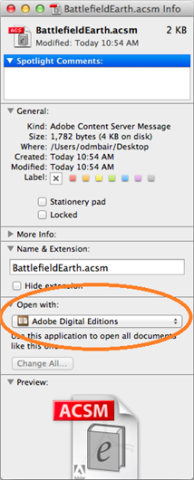Adobe Digital Editions 3.0 and above versions are designed to work with assistive technologies on Mac and Windows. You must separately install/enable these applications. Installation instructions can be found on the respective web sites (, or on Windows and on Mac). Version 3.0 and above are designed with support for full keyboard controls (tab navigation and shortcuts), improved text enlargement, and support for high-contrast modes. Shortcuts are listed in the Getting Started eBook that is installed along with the Adobe Digital Editions.
If you activate your computer with Digital Editions anonymously, all the purchased or borrowed books afterwards belong to that computer. If you activate your computer with Digital Editions with an ID, all the purchased or borrowed books afterwards belong to that ID. The books downloaded before activation will not be converted. Books can be copied from one device to another device.
If two devices are activated with the same ID, purchased books can be opened on the other device. If the other device is not activated or if it is activated with another ID, a pop up window will appear to ask for ID when opening the purchased books.
Borrowed books cannot be opened on another computer regardless its activation status. It is because that the loan token is not copied.
Change Default Folder Adobe Digital Editions Mac Download
Borrowed books and their loan tokens will be copied when transfer (not copy, this is an ADE feature) them between computer and device (e-reader). If the permission limits the books to be viewed on only one device, the copied books will not be able to be opened. Note that you can both authorize your computer with an Adobe ID, and selectively access individual books with alternate Ids, such as Vendor ID. Adobe Digital Editions will keep the two separate: if you download an eBook protected using a Vendor ID or Bookseller ID, then you’ll be prompted to access using that ID. Otherwise, it will either access to the Adobe ID you’ve authorized your computer with, or (if you chose not to authorize the computer with an Adobe ID) will authorize just for use on your computer. Digital Editions utilizes Adobe PDF technology that has been optimized for small code size and lower system requirements. It is optimized for performance and onscreen readability, rather than graphic arts or prepress-level fidelity.

As a result, some minor differences in graphics and font rendering are to be expected. In addition, the Digital Editions PDF implementation does not support several enterprise-oriented PDF features. These features are not typically used in PDF-based eBooks, and if present, they are ignored but may cause certain documents to render incorrectly. Digital Editions supports a superset of ISO standard 19005-1 (PDF/A).
PDF/A is designed to support more secure, long-term information archiving; it is based on a subset of PDF 1.4 (the version of PDF supported by Acrobat 5.0). Additional PDF capabilities in Digital Editions beyond PDF/A include basic encryption, DRM-based encryption, JBIG2 image compression, transparency, and compressed object streams. The intention is to support PDF features reasonably needed by eBooks and other commercially published content, balancing 100% coverage with a focus on small size and high performance. EPUB is the file extension of an XML format for reflowable digital books and publications. It consists of three open standards: Open Publication Structure (OPS), Open Packaging Format (OPF), and Open Container Format (OCF). EPUB is produced by the International Digital Publishing Forum (IDPF). EPUB allows publishers to produce and send a single digital publication file through distribution and offers consumers interoperability between software/hardware for unencrypted reflowable digital books and other publications.
As a publisher/content distributor, how can I securely distribute content for consumers to manage and consume via Digital Editions?Adobe offers a content protection service, Adobe Content Server. Adobe Content Server is a robust server solution that digitally protects PDF and reflowable EPUB content for Adobe Digital Editions and supported mobile devices.
Easy to integrate into existing systems using industry standard technologies, Content Server allows you to host, manage, and deliver files from your existing infrastructure to Digital Editions users.

In OS X, Apple’s Preview is the default application for opening a number of file types, including PDF’s. While versatile, Preview will NOT allow you to make changes to PDF’s with editable content. Follow these instructions to set Adobe Acrobat Reader as the default application for opening PDF files.Step 1:Single click a PDF file you wish to open or any PDF file in general while holding the Control key. Then select GET INFO from the menu you’ve opened.Step 2:Click the drop down menu for OPEN WITH.Step 3:Select ADOBE READER from the menu.Step 4:Click on the CHANGE ALL button to keep the changes.